Ccrn cardiac exam - Study guides, Class notes & Summaries
Looking for the best study guides, study notes and summaries about Ccrn cardiac exam? On this page you'll find 188 study documents about Ccrn cardiac exam.
Page 3 out of 188 results
Sort by
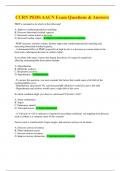
-
CCRN PEDS AACN Exam Questions & Answers
- Exam (elaborations) • 33 pages • 2024
-
- $10.64
- + learn more
CCRN PEDS AACN Exam Questions & Answers-PEEP is intended to do which of the following? A. Improve ventilation/perfusion matching B. Decrease functional residual capacity C. Increased venous return to the heart D. Increased cardiac output - A. Improve ventilation/perfusion matching - PEEP increases alveolar volume, thereby improving ventilation/perfusion matching and increasing functional residual capacity. - A detrimental effect of PEEP (especially at high levels) is a decrease in veno...
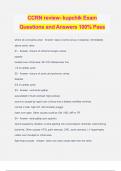
-
CCRN review- kupchik Exam Questions and Answers 100% Pass
- Exam (elaborations) • 15 pages • 2024
- Available in package deal
-
- $12.49
- + learn more
CCRN review- kupchik Exam Questions and Answers 100% Pass where do coronaries arise - Answer- base of aorta (sinus of valsalva); immediately above aortic valve S1 - Answer- closure of mitral & tricuspic valves systole loudest over mitral area, 5th ICS midclavicular line 1/3 of cardiac cycle S2 - Answer- closure of aortic and pulmonic valves diastole 2/3 of cardiac cycle S3 - Answer- ventricular gallop auscultated in fluid overload; high preload. sound is caused by rapid rush of bloo...
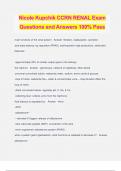
-
Nicole Kupchik CCRN RENAL Exam Questions and Answers 100% Pass
- Exam (elaborations) • 29 pages • 2024
- Available in package deal
-
- $13.49
- + learn more
Nicole Kupchik CCRN RENAL Exam Questions and Answers 100% Pass main functions of the renal system - Answer- filtration, reabsorption, secretion acid base balance, bp regulation (RAAS), erythropoietin (hgb production), electrolyte balances -approximately 20% of cardiac output goes to the kidneys the nephron - Answer- -glomerulus: network of capillaries, filters blood -proximal convoluted tubule: reabsorbs water, sodium, amino acids & glucose -loop of henle: reabsorbs Na+, water & concentr...
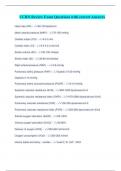
-
CCRN Review Exam Questions with correct Answers
- Exam (elaborations) • 10 pages • 2023
- Available in package deal
-
- $11.49
- + learn more
CCRN Review Exam Questions with correct Answers Heart rate (HR) - 60-100 beats/min Mean arterial pressure (MAP) - 70-105 mmHg Cardiac output (CO) - 4-5 L/min Cardiac index (CI) - 2.5-4.5 L/min/m2 Stroke volume (SV) - 50-100 ml/beat Stroke index (SI) - 35-60 ml/m2/beat Right arterial pressure (RAP) - 4-8 mmHg Pulmonary artery pressure (PAP) - Systolic 15-30 mmHg Diastolic 5-15 mmHg Pulmonary artery occlusive pressure (PAOP) - 8-12 mmHg Systemic vascular resistance (SVR) - 800-1200 dyne...
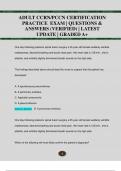
-
ADULT CCRN/PCCN CERTIFICATION PRACTICE EXAM | QUESTIONS & ANSWERS (VERIFIED) | LATEST UPDATE | GRADED A+
- Exam (elaborations) • 24 pages • 2024
- Available in package deal
-
- $12.49
- + learn more
ADULT CCRN/PCCN CERTIFICATION PRACTICE EXAM | QUESTIONS & ANSWERS (VERIFIED) | LATEST UPDATE | GRADED A+ One day following posterior spinal fusion surgery a 35 year old female suddenly exhibits restlessness, labored breathing and acute chest pain. Her heart rate is 122/min., she is afebrile, and exhibits slightly diminished breath sounds on the right side. The findings described above should lead the nurse to suspect that the patient has developed: A. A spontaneous pneumothorax B...
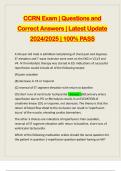
-
CCRN Exam | Questions and Correct Answers | Latest Update 2024/2025 | 100% PASS
- Exam (elaborations) • 23 pages • 2024
- Available in package deal
-
- $11.99
- + learn more
CCRN Exam | Questions and Correct Answers | Latest Update 2024/2025 | 100% PASS A 59 year old male is admitted complaining of chest pain and dyspnea. ST elevation and T wave inversion were seen on the EKG in V2,V3 and V4. IV thrombolytic therapy was started in ED. Indications of successful reperfusion would include all of the following except: (A) pain cessation (B) decrease in CK or troponin (C) reversal of ST segment elevation with return to baseline (D) short runs of ventricular tac...
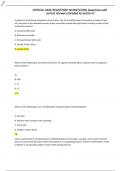
-
CRITICAL CARE REGISTERED NURSE (CCRN) QUESTIONS WITH CORRECT ANSWERS (GRADED A) SECTION D
- Exam (elaborations) • 31 pages • 2024
- Available in package deal
-
- $10.00
- + learn more
A patient in the ED with complaints of chest pain. The 12-lead EKG shows ST elevation in leads V3 and V4. Occlusion of the affected coronary artery most likely would affect perfusion to which portion of the conduction system? A. Sinoatrial (SA) node B. Bachmann's bundle C. Atrioventricular (AV) node D. Bundle of His LAD so D. bundle of his Which of the following is the preferred lead for ST segment monitoring for a patient with a suspected RCA occlusion? A.I B. aVR C. III D. V1 c. III ...
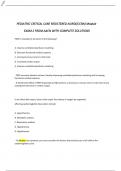
-
PEDIATRIC CRITICAL CARE REGISTERED NURSE (CCRN) MODULE EXAM 2 FROM AACN WITH COMPLETE SOLUTIONS
- Exam (elaborations) • 56 pages • 2024
- Available in package deal
-
- $11.00
- + learn more
PEEP is intended to do which of the following? A. Improve ventilation/perfusion matching B. Decrease functional residual capacity C. Increased venous return to the heart D. Increased cardiac output A. Improve ventilation/perfusion matching - PEEP increases alveolar volume, thereby improving ventilation/perfusion matching and increasing functional residual capacity. - A detrimental effect of PEEP (especially at high levels) is a decrease in venous return to the heart and a subsequent decre...
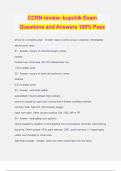
-
CCRN review- kupchik Exam Questions and Answers 100% Pass
- Exam (elaborations) • 15 pages • 2024
- Available in package deal
-
- $12.49
- + learn more
CCRN review- kupchik Exam Questions and Answers 100% Pass where do coronaries arise - Answer- base of aorta (sinus of valsalva); immediately above aortic valve S1 - Answer- closure of mitral & tricuspic valves systole loudest over mitral area, 5th ICS midclavicular line 1/3 of cardiac cycle S2 - Answer- closure of aortic and pulmonic valves diastole 2/3 of cardiac cycle S3 - Answer- ventricular gallop auscultated in fluid overload; high preload. sound is caused by rapid rush of bloo...
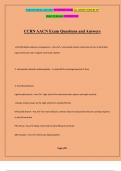
-
CCRN AACN Exam Questions and Answers
- Exam (elaborations) • 87 pages • 2024
- Available in package deal
-
- $12.49
- + learn more
CCRN AACN Exam Questions and Answers atrial fibrillation adverse consequences - Ans:-1. decreased cardiac output due to loss of atrial kick, rapid ventricular rate, irregular ventricular rhythm 2. tachycardia induced cardiomyopathy - in rapid afib for prolonged period of time 3. thromboembolism right bundle branch - Ans:--right side of the interventricular septum and right ventricle -impulse travels slower as the right ventricle is smaller/thinner left bundle branch - Ans:-two main divisi...

Did you know that on average a seller on Stuvia earns $82 per month selling study resources? Hmm, hint, hint. Discover all about earning on Stuvia


